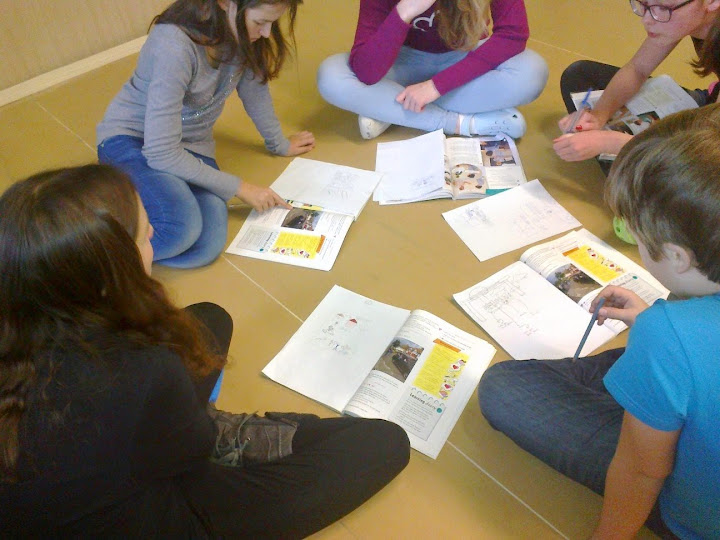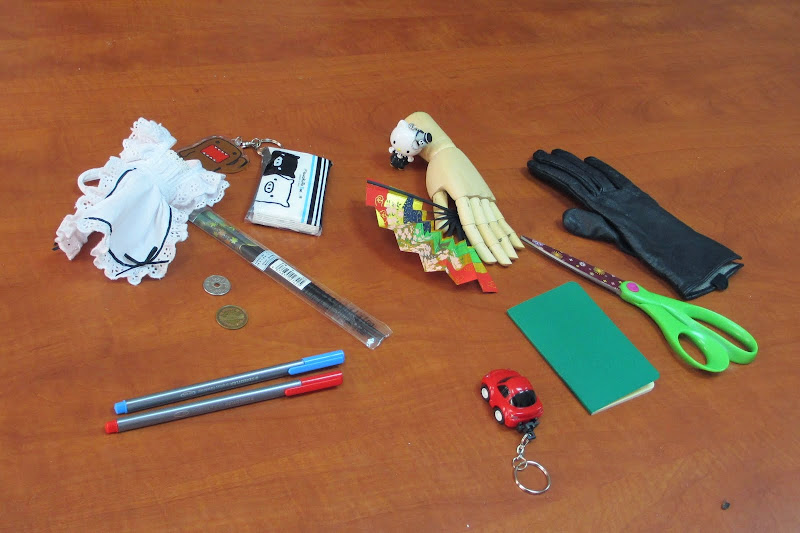The development of students’ self-awareness of their learning styles has long been a concern of mine; that is, students' self-awareness of their learning styles can be used as a tool to improve the process of learning EFL.

People learn on their own, in their own particular, individual way. Learning depends upon many factors, many of them personal. In order to be better learners, then, people need to learn about their preferred learning modalities. Forearmed with this knowledge, they probably will be better able to structure their learning situations to suit their styles. Teachers who know this can help their students better.
Students learn in different ways. Needless to say, thinking about how they learn and learning how to learn is important to help them accomplish their goals. How they accomplish this is as individual as their learning process.
Brown (1994) says that styles characterise the consistent and rather enduring traits, tendencies, or preferences that may differentiate one person from another. I would define learning style as individual preferences learners take so that learn better, that is, “an individual’s natural, habitual and preferred ways of absorbing, processing, and retaining new information and skills.” Learning styles will affect a person’s general approach to learning.
LEARNING STYLES: HISTORICAL AND LINGUISTIC BACKGROUND
According to The Dictionary of Language Teaching and Applied Linguistics (1992), learning style is “the particular way in which a learner tries to learn something. In second or foreign language learning, learners may prefer different solutions to learning problems. Some may prefer explanations of grammatical rules while some others prefer writing down words or sentences so that help them remember vocabulary better. Such differences are pointed as being differences in cognitive styles.”
Carl Jung (1927) was one of the first who noted major differences in the way people perceived (sensation versus intuition), the way they made decisions (logical thinking versus imaginative feelings), and how active or reflective they were while interacting (extroversion versus introversion). This relates to learning, because teachers and educators began to see learners as individuals who have different ways of learning. It was also seen that the process of learning was not always effective due to the lack of awareness on the part of the teachers and learners about how they learned. For Rogers, the goal of education is the facilitation of change and learning. Learning how to learn is more important than being “taught” something from the “superior” vantagepoint of a teacher who unilaterally decides what shall be taught. What is needed, according to Rogers, is real facilitators of learning, and one can only facilitate by establishing an interpersonal relationship with the learner.
The idea of learner training is not new, but there has recently been a revival of interest in this dimension of language teaching and learning. Ellis and Sinclair note that this revival is probably due to the development of more learner-centred approaches, which has led to a great focus on the learners as individuals and on the promotion of learner autonomy. The other aspect is the growth of respect for the individual in society, in which the concept of autonomy is defined as the “ability to assume responsibility for one’s own affairs,” and the opportunity to acquire this autonomy is viewed as a fundamental human right. This grew from the ideas of people such as Carl Rogers (1969) and Paulo Freire (1972).
For Rogers, the goal of education is the facilitation of change and learning. Learn how to learn is more important than being “taught” something from the “superior” vantagepoint of a teacher who unilaterally decides what shall be taught. What is needed, according to Rogers, is real facilitators of learning, and one can only facilitate by establishing an interpersonal relationship with the learner.
Following Rogers’ tradition, there was the well-known Brazilian educator Paulo Freire, whose seminal work Pedagogy of the Oppressed (1970) has inspired teachers to consider the importance of the empowerment of students in classrooms. Freire vigorously objected to traditional “banking” concepts of education, in which teachers think of their task as one of “filling” students “by making deposits of information which they consider to be true knowledge - deposits which are detached from reality” (1970:62). Instead, Freire argued, students should be allowed to negotiate learning outcomes, to co-operate with the teacher and other learners in a process of discovery, “to engage in critical thinking and relate everything they do in school to their reality outside the classroom.” Thus empowered to achieve solutions to real problems in the real world, “learners are liberated” - that could help learners learn best.
Isabel Myers and Katherine Briggs (1977), who created the Myers Briggs typology of indicator and founded the Association of Psychological Type, applied Jung’s work and influenced a generation of researchers trying to understand specific differences in human learning. These studies about different styles of learning have shown a deep concern about how learners learn better. The students also include the field of learning English as a Foreign Language (EFL), and have brought significant changes in English Language Teaching (ELT), leading to the actual studies related to learning styles.
Jeremy Harmer (1991), reviewing the major approaches that influenced language teachers, concluded that no one knows exactly how people learn. In my reading, I have concluded that there are three major streams to understand language learning: Behaviourism, Cognitivism, and Humanism.
What we know about learning now has been affected by those theories and approaches developed in the past and which have helped us to understand the process of second language learning and acquisition. We cannot deny the particular advantages of each of those theories, and also some others of equal importance.
AN OVERVIEW OF LEARNING STYLES AND THEIR APPLICATION IN L2 CLASSROOM:
There are different types of learning styles – cognitive, sensory, and personality (Reid 1995). The familiar perceptual learning styles (visual, auditory, kinaesthetic) are only one piece of a much large learning-style picture. The terminology and labels used for identifying learning styles vary greatly.
These perceptual learning styles have been the subject of learning styles research. Researchers generally agree that these modalities of learning are distinguishable, though whether they represent learning styles or learning differences remains to be seen.
A major issue for modern language teaching is the work associated with Neurolinguistic Programming (NLP). Neurolinguistics Programming constitutes “an attitude to life" (Revell and Norman 1997). It is also a collection of techniques, patterns, and strategies for assisting effective communication, personal growth and change, and learning. It is based on a series of underlying assumptions about how the mind works and how people act and interact.
According to the NLP theory, we experience the world through our five senses or representational systems. These are visual, auditory, kinaesthetic, olfactory, and gustatory, called VAKOG for short. Individuals use all the five systems, but the three most people use predominately are the visual, the auditory, and the kinaesthetic system, mainly when they are learning a language or any other subject in the classroom.
VISUAL
When the VISUAL style is preferred, people are actually thinking in images or pictures. It is as if they have a movie camera in their mind. They take in what they hear or read and translate it into images in their brain. We call these people VISUAL learners. When VISUAL learners want to recall what they have learned, they simply glance upward and look at the image that they have stored on their "picture screen." This process is much like going to the movies and then recalling what they have seen in order to tell a friend. The memory process is taking place by reviewing the pictures from the movie and then easily talking about the story line to someone else. Visual learners speak in terms of, "I see, I get the picture."

In a classroom, VISUAL learners perform very well because all testing is conducted in a written "visual" format. This requires that VISUAL images be made when recalling information. Good readers read the black and white text and then convert the information into pictures. This makes the memory process easier. VISUAL people will easily conform to most classroom standards, such as sitting quietly, writing neatly and organising materials well.
KINAESTHETIC
The second learning style is defined as KINAESTHETIC. These people prefer to learn through their body or feelings. If they can touch it and feel whatever they are learning about involving their bodies, KINAESTHETIC learners will process and remember the information quite well. As students in a classroom, these learners are usually quite restless, have more difficulty paying attention, and can't seem to get "focused" (a visual term). These learners like to speak about learning in terms of their feelings and say things like "I feel," or "I'd like to get a better handle on this information."

KINAESTHETIC learners do not have the internal pictures of neatness and organisation that visual learners make so easily in their minds. This is one of the reasons that kinaesthetic learners have a more difficult time demonstrating what they know in a traditional classroom. Children who prefer the KINAESTHETIC learning style are not usually making pictures in their minds. If they do not make pictures, it follows that there are no pictures to either keep neat, or to "mess up." Therefore, it is normal for them not to be organised.

The KINAESTHETIC student will excel in a classroom where book reports can be "acted out" and can choose assignments which allow them to build projects.
AUDITORY
The third type of learner is known as the AUDITORY. They learn best by hearing or listening. These people do not necessarily make pictures in their minds, as do the visual learners, but rather filter incoming information through their listening and repeating skills. The AUDITORY learners tell wonderful stories and solve problems by "talking" about them.

The excellent hearing and listening skills of this type of learner are what make great musicians, disc jockeys, psychologists, etc. Speech patterns will represent exactly how the AUDITORY person think, i.e., "I hear ya,” “that clicks,” “that sounds right,” “that rings a bell," etc. In school, AUDITORY learners learn by listening and can easily repeat statements back to the teacher. AUDITORY students like class discussions, but can become easily distracted. Of the three styles, the AUDITORY is the most talkative and has more difficulty writing.
CONCLUSION

Students can take advantages of their learning styles to develop strategies to use EFL effectively.
To create lessons addressed to the different styles of students is not easy. To focus on every learning style in every lesson is also time consuming. Ideally, we should try to incorporate as many different styles as possible in each lesson. By providing a variety of ways for students to perceive and process information in a lesson, it’s necessary to address the needs of the students and make adjustments to our teaching. In this way, it will be possible to recognise what learning styles are being addressed and make adjustments in our teaching as necessary.
I conclude that the awareness of learning styles both on the part of the teacher and on the part of the students is an excellent tool to inform both teacher’s and learners’ strategies to help in developing effective teaching and learning processes.
Working with learning styles makes us rethink our teaching practice, and gives us fundamental elements to build up a more appropriate methodology to lead our students to the more effective learning of EFL.
After all, everybody deserves the right to learn. And learning to learn should be a learners’ right, rather than a privilege.
For sure, a good work upon our students’ learning styles can influence their view of what learning is and will certainly make changes in our teaching. Based on the data regarding the learning preferences of your students, they will be able to incorporate the use of appropriate strategies to improve learning efficiency and, as a teacher, it enables us to pay much more attention to our students' needs and find ways to help them learn better.
Bibliography
BROWN, H. Douglas, Teaching by Principles – An Interactive Approach to Language Pedagogy, Prentice Hall, third Edition 1994
BROWN, H. Douglas, Principles of Language Learning and Teaching, Prentice Hall, 1994
DAVIS, Evelyn C., NUR, Hafsah & RURU, Sophia A. A., “Helping Teachers and Students Understand Learning Styles” in English Teaching Forum Volume 32 # 3, July 1994
ELLIS, Gail & SINCLAIR, Barbara, Learning to Learn English A Course in Learner Training – Teacher’s Book, Cambridge University Press, fifth edition 1995
FREIRE, Paulo, Pedagogia do Oprimido, São Paulo, Record 1983
HARMER, Jeremy, The Practice of English Language and Teaching Longman Handbooks for Language Teachers, tenth edition, Longman 1996
HARRIS, Michael & McCANN, Paul, Assessment Handbooks for the English Classroom, Heineman 1994
Roseli Serra, the ESL Editor for Wandering Educators, is an educator from Recife, Brazil, where she lives and works. She started as a private teacher of English and Portugues at the age of 17 years, and has a degree in Psychology and in Arts & Humanities, majoring in English, Portuguese, and Literature in English and Portuguese. She’s post graduate in Applied Linguistics for ELT. She’s also an ELT and consultant, E-Moderator, teacher, teacher trainer, mentor, Cambridge Examiner, and Materials Writer. Roseli has been in the field of ELT/ ESL and EFL for over 30 years now. She loves writing, mentoring, and mainly sharing about education. She loves working with technology and teaches different age groups, from 10 year-old students to adults. She has also experienced being the DOS of a language institute in Brazil for many years. You can find her online at http://roseliserra.blogspot.com.br
All photos courtesy and copyright eltpics: https://www.flickr.com/photos/eltpics
